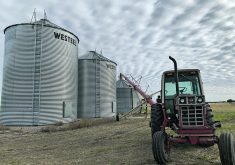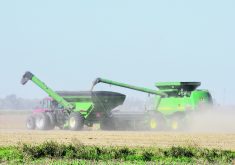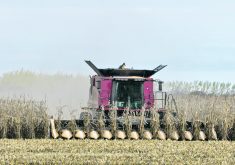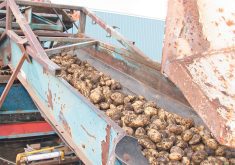Government ministry issues final crop report of the season as it summarizes how different crops fared in the province
Central Manitoba farmers reported a significant drop in yields this year, based on the provincial government’s year-end summary.
It said producers in these drier regions had yields of 30 to 35 bushels per acre compared to the provincial average, which was between 55 and 60 bu. per acre. Acres that received much-needed precipitation reported yields of 60 to 80 bu. per acre.
Andrew Hector, agronomy extension specialist for cereal crops with the Manitoba Crop Alliance, saw protein content also showing variability.
“Spring wheat quality was fair to good overall, with high protein levels mostly reported. Although, there was a pocket in the northwest where low protein was found.”
Read Also

New coal mine proposal met with old concerns
A smaller version of the previously rejected Grassy Mountain coal mine project in Crowsnest Pass is back on the table, and the Livingstone Landowners Group continues to voice concerns about the environmental risks.
Morgan Cott, agronomy extension specialist for special crops with the Manitoba Crop Alliance, said quality has been good and corn yields have ranged from 80 to 200 bu. per acre. However, Cott expected a drop from the provincial average yield achieved in 2022.
Sunflower yields are being reported from 1,700 to 3,500 pounds per acre, with most farmers in the 2,000 to 2,500 lb. per acre range, according to the report. However, they have seen outstanding yields in areas that received moisture in an incredibly dry year, said Cott.
Producers are still trying to get their corn and sunflower harvest complete with 49 and 58 percent, respectively, left in the field as of the release of the provincial summary.
The provincial soybean average is expected to top 34 bu. per acre with four percent still left to harvest. Yields depended on rainfall with early reports showing 20 to 30 bu. per acre, which later jumped to 30 to 40 bu. per acre as harvest progressed.
Flax harvest is also nearing completion, said Cott.
“Flax saw some pretty good yields, but also some fields reported very low yields. I don’t suspect that provincial average will be outside the norm.”
The report said canola yields came in at 40 to 50 bu. per acre. While it had the odd report of 60 bu. per acre in most regions, Manitoba Agriculture is predicting a 42 bu. per acre provincial average.
Oat yields were good throughout the province, especially in areas that received significant moisture. Those acres were coming in at 120 to 160 bu. per acre while crops in the central region reported 80 to 100 bu. per acre.
Livestock farmers reported adequate feed stocks for the winter months, despite the challenges of a hot and dry summer. Herds were being moved to alfalfa fields earlier than expected in summer, especially with pastures being quickly depleted of spring moisture.
The same is being said for September grazing as some herds had already been moved to winter grazing areas sooner than producers wanted. However, 40 percent of producers are reporting a surplus of animal feed, 50 percent are reporting adequate amounts for the winter, and the other 10 percent are short heading into winter.
There should be adequate supply for farmers who need to find additional feed sources, said the report. Silage corn is reporting at nine to 20 tonnes per acre, which is higher than producers expected, with forage supplies and cereal bale yields coming in better than in 2022.
Farmers still need significant snowfall to replenish pasture and crop land, but water supplies had been adequate throughout the year. Dugouts are going into the fall freeze-up at 50 to 60 percent capacity, said the report.
Looking at the year, farmers were in the field to seed by the second week in May and had most seeding finished by the second week in June.
It was a slow start to harvest, with no significant percentage completed until the third week of August. However, by the first week of September, producers were beginning to pull ahead of the five-year average, a trend that continued to last week.
As of Oct. 24, harvest was sitting at 96 percent complete, a six percent increase over the five-year average of 90 percent.
Farmers have also completed their fall field work.

















